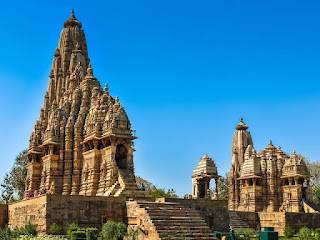Khajuraho Temples
Khajuraho Temples: A Marvel of Erotic Sculptures and Spiritual Grandeur
The Khajuraho Temples, located in the Chhatarpur district of Madhya Pradesh, India, are a UNESCO World Heritage site renowned for their exquisite architectural beauty and intricate sculptures. Dating back to the Chandela dynasty of the 10th and 11th centuries, these temples stand as a testament to the artistic and cultural grandeur of ancient India.
The temples of Khajuraho are famous for their intricate carvings, particularly the erotic sculptures that adorn the outer walls. These sculptures depict various aspects of human life, including love, passion, and sensuality. Contrary to popular belief, the explicit nature of these carvings is not solely focused on eroticism but serves as a reflection of the all-encompassing nature of human emotions and desires. These sculptures also symbolize the celebration of physical and spiritual union.
The architectural style of the Khajuraho Temples is a harmonious blend of Nagara and Dravidian styles, showcasing the brilliance of Indian temple architecture. The temples are divided into three groups: the Western Group, Eastern Group, and Southern Group. Each group houses several temples dedicated to different deities, such as Lord Shiva, Lord Vishnu, and the Jain Tirthankaras.
The Western Group, the largest and most well-known cluster, includes temples like Kandariya Mahadeva Temple, Lakshmana Temple, and Vishvanatha Temple. These temples feature towering shikharas (spires), intricately carved mandapas (pavilions), and beautifully sculpted figures. The Kandariya Mahadeva Temple, with its 31-meter high spire and over 800 sculptures, is a masterpiece of temple architecture.
The Eastern Group comprises temples like Brahma Temple, Vamana Temple, and Javari Temple. Though smaller in size, these temples are equally stunning, with exquisite carvings depicting various gods, goddesses, and celestial beings. The Eastern Group temples are known for their tranquility and serene ambiance.
The Southern Group, located away from the main complex, houses the Dulhadev Temple, Chaturbhuj Temple, and Beejamandal Temple. The Dulhadev Temple is dedicated to Lord Shiva and boasts a magnificent lingam (symbol of Shiva) within its sanctum sanctorum.
The Khajuraho Temples are not only an architectural marvel but also hold immense religious and spiritual significance. They stand as a testament to the religious tolerance and diversity prevalent during the Chandela dynasty. The temples served as a center for religious rituals, pilgrimage, and scholarly pursuits, attracting devotees and scholars from far and wide.
Over the centuries, the Khajuraho Temples faced various challenges, including invasions, neglect, and natural weathering. However, they have been meticulously restored and preserved by archaeological authorities, allowing visitors to experience the awe-inspiring beauty of these ancient structures.
Today, the Khajuraho Temples continue to captivate visitors from around the world, offering a glimpse into India's rich cultural and artistic heritage. The sculptures, with their intricate detailing and artistic finesse, provide a unique window into the aesthetics and craftsmanship of the past. The temples stand as a reminder of the creative genius and spiritual legacy of the ancient civilization that once thrived in the heart of India.
Visiting the Khajuraho Temples is a mesmerizing journey through time, where one can immerse oneself in the mystical allure of ancient India. It is an opportunity to appreciate the splendor of human creativity and the enduring power of art to transcend time and boundaries. The Khajuraho Temples truly exemplify the timeless beauty of India's architectural and sculptural heritage




.jpeg)
Comments
Post a Comment